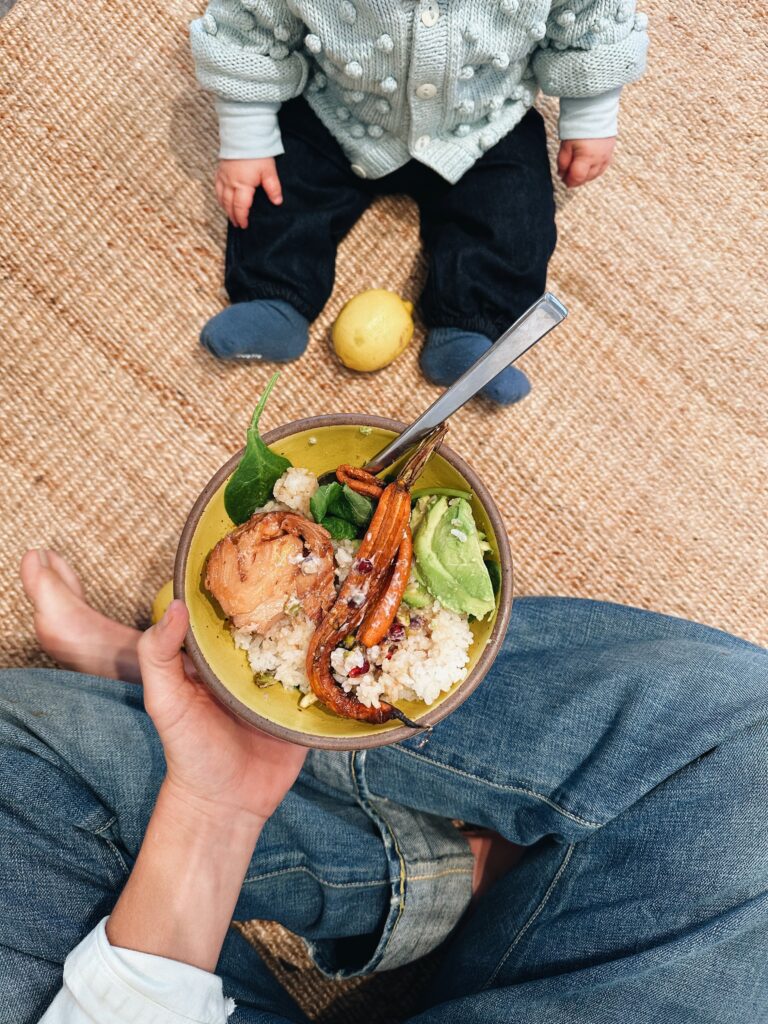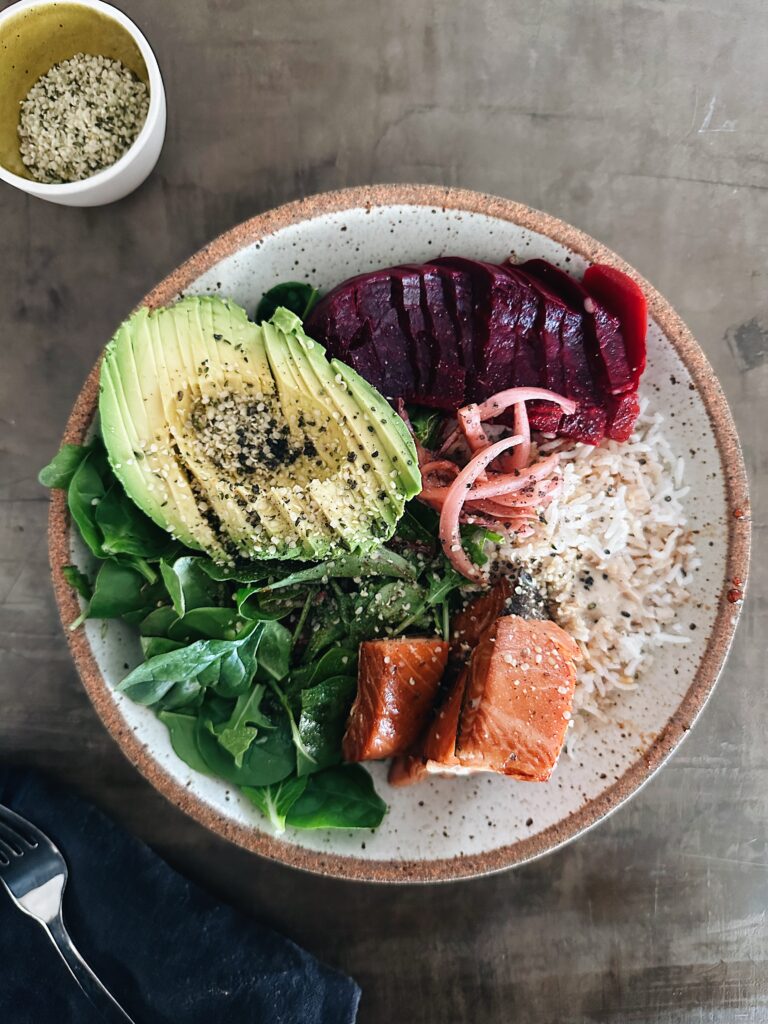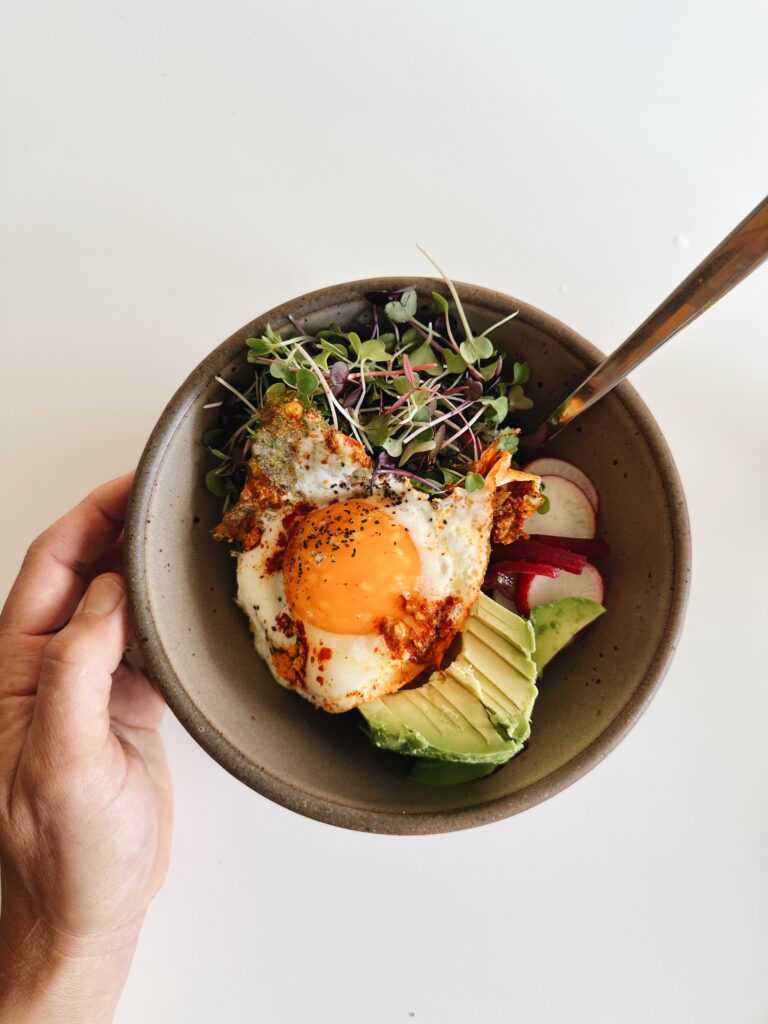

Say goodbye to “macros” and hello to a better more bad-ass bowl.
When it comes to eating Ayurvedically, simplicity is the first unlock.
Honoring the Six Flavors is the second. “What? Why?” you ask?
Because – newsflash: our bodies don’t recognize the value of “macros.”
Our bodies recognize the value of our foods by the FLAVORS we taste. When we put a portion of food in our mouths, our tongues taste the flavor and send a message to the digestive system to start making enzymes to break down that food. These messages also contain information about the bioenergetic benefits we’re about to receive (microbiome does a happy dance!) Each of the Six Flavors has a unique bioenergetic benefit; nutrifying, detoxifying, reducing inflammation, hydrating, tonifying, rebuilding, boosting absorption, and strengthening digestion among them. This is why, in Ayurvedic medicine, we don’t build our meals with sorta-meaningless macros. alone. We build with FLAVORS.
There are a few great reasons to build with flavors instead of macros, to aim for having all Six Flavors present in each of your meals. But three specifically come to mind.
The first? Eating for flavor is one of the most natural ways that you can build healthy, nourishing plates. Flavors are the mechanism that nature derived so that we – and other species – could navigate the vast world of nourishment. Since the beginning of time, flavors have been indicating to our bodies whether a food had value or not (sweet fruits? good! pungent poisonous berries? bad!) Eating and honoring this system is one of the easiest ways we can realign with the seasons, and learn to navigate the world of food sustainably, healthfully and in balance.
The second: Your meals will taste BETTER. So much better! Whether its a pinch of salt, a squeeze of lime, a little pinch of chili pepper or ginger – our bodies enjoy rounded meals more. Big bowls of ramen? A burger with all the fixings? These are great examples of highly craveable foods that contain all Six Flavors.
The third: building with flavors, and including all six at every meal ensures that inflammation stays at bay, and that the pH balance in the body remains, well, balanced. When we eat too many sweet flavors (proteins, fats and carbohydrates) without eating enough vegetables inflammation presents because the body requires some alkaline foods and flavors to balance. If we eat too many vegetables (astringent and bitter flavors,) then we also find the body becomes inflamed because we require more acidic foods (those found in sweet flavors.)

Macronutrients were founded by nature too…but not as a means of us navigating which foods to eat or not eat. Macronutrients like protein, fats and carbohydrates are all types of sweet-flavored foods; the most nourishing, building, anti-inflammatory foods we can eat. And they are important for us to consume! And so it isn’t necessary for us to cast them off, despite the fact that nutritionism has so blatantly vilified different food groups for lack of understanding.
Instead, embracing these macronutrients is the most sensible. And, recognizing that these foods ARE sweet is important. Many macronutrients – to include animal proteins, dairy, grains, carbohydrate-rich root vegetables, and fats like ghee, butter and more – all have sweet flavors. And as such, the sweet flavor needs to be the most plentiful on our plates!
This acknowledgement – that proteins, fats and carbohydrates – are sweet is critical. These are the building blocks of good nutrition, naturally derived and “discovered” by science. When we have cravings for sweet foods, THESE are the foods that our bodies are requesting. (ie: our cravings for sweet foods are NOT always cake!)
I’ve been asked to create a spreadsheet with all the foods and their flavors. Ha. There are SO MANY foods this would be impossible, my friends.
The best way to learn what foods are what flavors is to TASTE them! And when you do, you’ll find:
SWEET:
These are animal proteins, dairy products, nearly all whole grains, sweet fruits, root vegetables, sweeteners and of course treats.
SOUR:
This flavor comes from citrus fruits such as lemons, limes and oranges, but also from fermented foods: vinegar, pickles, yogurt and more.
SALTY:
Salty flavors come from salt! And sea vegetables and foods that come from the sea also have a hint of salty flavor.
BITTER:
This flavor is found in most raw vegetables such as broccoli, brussel sprouts, cabbage, cauliflower, radishes and the like. Coffee and pure cacao (chocolate) are also bitter.
ASTRINGENT:
Leafy greens, fresh herbs, legumes, turmeric, sesame seeds – these are astringent foods. Any food that kicks the roof of your mouth and leaves a tart residue like a glass of red wine has an astringency.
PUNGENT:
Spicy foods are pungent. These include black pepper, ginger and cumin as well as spicy peppers and chilis, all alliums (onions, garlic, shallots.)
It’s important to mention that many foods possess more than one flavor, which can be complicating when we’re trying to categorize each. For example, avocados are sweet AND astringent. Cinnamon is pungent AND sweet.

If you’ve long been building your meals around macronutrients, shifting directions and instead building around the Six Flavors can be tricky. It’s a concept that stumps most of my clients until I share this blueprint with them – empowering beautiful, powerful bowls to be made with the ingredients they have on hand, plus a few extra little zhooshes to make flavorful, Ayurvedically-balanced meals easily.
As a general rule, and as I described above, as athletes we want sweet-flavored foods (and each of the macronutrient categories) to be present on the plate at every meal. These sweet flavors are supplemented by bitter and astringent foods; especially in the winter, our bodies are unlikely to appreciate an entire plate of bitter and astringent foods which are drying and cooling (ie: like a salad!) Instead, enjoying these flavors as an accompaniment is the way to play. Lastly, we have sour, salty and pungent foods which we also want to enjoy in moderation. A squeeze of lemon or a splash of vinegar, a sprinkle of pepper and salt and we’ve covered these bases.
The blueprint below gives you a rough outline of how to build a Six Flavored Winter Bowl for yourself, with the ingredients you love and have on hand. There are one million ways to combine these ingredients to make something delicious! Here are a few favorites of mine:
Salmon Bowl:
smoked salmon + steamed quinoa + roasted beets + avocado + torn spinach + shredded carrots + pickled onions + rice vinegar + salt/pepper + Bragg’s + maple
Roasted Chicken Bowl:
roasted chicken + steamed brown rice + roasted sweet potato + roasted brussel sprouts + sprouted pumpkin seeds + squeeze of lime + salt/pepper + Bragg’s + maple
Amped Fried Egg Bowl:
2 eggs fried in ghee + steamed sushi rice + microgreens + avocado + furikake + pickled radish + rice vinegar + salt/pepper + bragg’s + maple
Grilled Halloumi Bowl:
grilled halloumi + steamed quinoa + arugula + roasted squash + hemp seeds + lemon juice + salt/pepper + bragg’s + maple

Beans and legumes are proteins…and one of the only proteins that do not have a sweet taste in Ayurveda. Instead, these ingredients are astringent in flavor. (This is all the more reason that it’s important for vegans to enjoy nuts, ample grains and other fats – to counteract the abundance of alkaline foods in their diets.)
Most days for lunch I’m enjoying a bowl like this. It powers me through my day, and into the evening and this strategy (that fuels the microbiome!) is the same that I recommend to all of my pro clients. So how to put this all together in your house? Easy peasy.
It’s likely that you’re already doing a good bit of the leg work – incorporating proteins, fats, carbs. Now, we just need to make sure you’re getting vegetables (bitter,) some greens (astringent,) and then adding a bit of salty/sour/pungent (squeeze of lemon! sprinkle of salt! cracks of pepper!)
It’s important to note that the way that this strategy works for me is that I have my ingredients on hand, and at the ready. I use a rice cooker to make grains each morning, so I have them ready for lunchtime. I keep tinned fish and eggs at the ready, and I use meat or chicken if I have these ingredients left over from dinner the night before.
As for vegetables, always always ALWAYS choose what’s in season. The vegetables listed below are all suitable for fall and winter bowls.
Lastly, this is a principle that can be applied to ANY meal, at any time of day. Start tasting, practicing, playing and thriving!
I include some additional notes about how to build great bowls in the Recipe Notes below.
Get after this one! And enjoy!
That's ok, just sign up or log in to see this recipe.